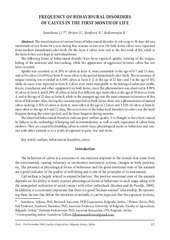Приказ основних података о документу
Frequency of behavioural disorders of calves in the first month of life
| dc.creator | Samolovac, Ljiljana | |
| dc.creator | Hristov, Slavča | |
| dc.creator | Stanković, Branislav | |
| dc.creator | Beskorovajni, Radmila | |
| dc.date.accessioned | 2023-10-19T08:13:50Z | |
| dc.date.available | 2023-10-19T08:13:50Z | |
| dc.date.issued | 2018-11-23 | |
| dc.identifier.isbn | 978-86-7834-316-2 | |
| dc.identifier.uri | http://r.istocar.bg.ac.rs/handle/123456789/916 | |
| dc.description.abstract | The manifestation of various forms of behavioural disorder in calves up to 30 days old was monitored on two farms for a year during four seasons in one year. On both farms calves were separated from mothers immediately after birth. On the farm A calves were tied in the first week of life, while at the farm B they were kept in individual boxes. The following forms of behavioural disorder have been reported: apathy, twisting of the tongue, licking of the substrate and intersucking, while the appearance of aggression between calves has not been recorded. Apathy was recorded in 16.28% of calves at farm A, most commonly in the age of 0-7 and 15 days, and in 84 calves (14.69%) at farm B, most often in the period immediately after birth. The occurrence of tongue twisting was recorded in 0.50% calves at farm A (2 at the age of 22 days and 1 at the age of 30), while no cases were reported at farm B. Calves were more susceptible to the licking of substrates (walls, fences, truncheons and other equipment) on both farms, since this phenomenon was observed in 8.89% of calves at farm A and 8.39% of calves at farm B at different ages; most often at the age of 30 days at Farm A, and at the age of 22 days at Farm B, while in the youngest age was the most common occurrence of this form of behaviour. Also, during the examined period on both farms there was a phenomenon of mutual calves sucking, 2.35% of calves at farm A, most often at the age of 22 days and 3.32% of calves at farm B, most often at the age of 8 and 22 days. The occurrence of the behavioral disorders in calves was the most frequent during the winter period, and the least frequent during autumn. The observed behavioural disorders indicate poor welfare quality. It is thought to have been caused by failures in the technology of keeping and accommodation, as well as early separation of calves from mothers. They are caused by disabling calves to satisfy basic physiological needs in behaviour and contact with other animals or as a result of exposure to pain, fear and stress. | sr |
| dc.language.iso | en | sr |
| dc.rights | openAccess | sr |
| dc.rights.uri | https://creativecommons.org/licenses/by/4.0/ | |
| dc.source | Poljoprivredni fakultet, Beograd-Zemun | sr |
| dc.subject | welfare | sr |
| dc.subject | behavioural disorders | sr |
| dc.subject | calves | sr |
| dc.title | Frequency of behavioural disorders of calves in the first month of life | sr |
| dc.type | article | sr |
| dc.rights.license | BY | sr |
| dc.citation.spage | 227 | |
| dc.identifier.rcub | https://hdl.handle.net/21.15107/rcub_ristocar_916 | |
| dc.identifier.fulltext | http://r.istocar.bg.ac.rs/bitstream/id/4366/bitstream_4366.pdf | |
| dc.type.version | publishedVersion | sr |


